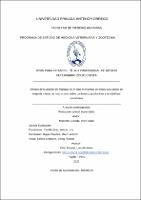| dc.contributor.advisor | Ortiz Tenorio, Luis Abraham | |
| dc.contributor.author | Molocho Lozada, Imer Odan | |
| dc.creator | Molocho Lozada, Imer Odan | |
| dc.date.accessioned | 2023-11-22T17:18:58Z | |
| dc.date.available | 2023-11-22T17:18:58Z | |
| dc.date.issued | 2023 | |
| dc.identifier.uri | https://hdl.handle.net/20.500.12759/11632 | |
| dc.description.abstract | En la avicultura de engorde, la formulación de dietas balanceadas a costos óptimos, cada día es de mayor desafío, por el aumento de precio de los insumos, así como su alterada disponibilidad, han encarecido las dietas alimenticias. El objetivo de nuestro estudio fue evaluar el efecto de la inclusión de xilanasa en dietas de pollos de engorde de menor valor calórico con menos insumos energético sobre el desempeño productivo y rentabilidad. Se emplearon 120 pollos bebé de 1 día de edad de la línea cobb500, los cuales se distribuyeron en tres tratamientos, DB: Dieta base (Sin xilanasa), DB80: Dieta base con xilanasa menos 80 kcal/kg y DB120: Dieta base con xilanasa menos 120 kcal/kg, con cinco repeticiones. El trabajo se realizó durante los meses de junio y julio del 2022 (1 a 42 días de edad); en la granja La Soledad; ubicado en km 592 Chicama; provincia de Ascope departamento de la Libertad. Los resultados fueron analizados a través del análisis de varianza y no mostraron diferencia estadística en ninguna de las variables estudiadas; no obstante, los tratamientos con xilanasa con dietas hipocalóricas de DB80 kcal/kg y DB120 kcal/kg mostraron mayor peso final y mayor ganancia de peso, (3.11kg; 3.17kg y 72.65g; 73.96g respectivamente), en relación con la dieta base sin xilanasa (DB: 3.07kg y 71.71g). En cuanto al consumo de alimento, los resultados fueron favorables para los tratamientos con xilanasa DB80: 132.38g y DB120: 132.81g, en comparación con el tratamiento sin xilanasa DB:128.98g. La conversión alimenticia fue similar para todos los tratamientos (DB:1.80, D80:1.82, DB120:1.80). Obteniéndose mayor rentabilidad en los tratamientos con xilanasa, con 55.15 y 58.98%; frente a 52.74% del tratamiento sin xilanasa. Por lo tanto, se concluye que la inclusión de xilanasa en dietas con menor valor energético genera el aporte energético necesario, que no afecta negativamente el desempeño productivo y aumenta la rentabilidad. | es_PE |
| dc.description.abstract | In broiler poultry, the formulation of balanced diets at optimal costs is becoming more challenging every day, due to the increase in the price of inputs, as well as their altered availability, have made diets more expensive. The objective of our study was to evaluate the effect of the inclusion of xylanase in broiler diets of lower caloric value with less energy inputs on productive performance and profitability. 120 1-day-old baby chickens of the cobb500 line were used, which were distributed in three treatments, DB: Base diet (Without xylanase), DB80: Base diet with xylanase with less than 80 kcal/kg and DB120: Base diet with xylanase minus 120 kcal/kg with five replicates. The work was carried out during the months of June and July 2022 (1 to 42 days old); at La Soledad farm; located at km 592 Chicama; province of Ascope department of Liberty. The results were analyzed through the analysis of variance and did not show a statistical difference in any of the variables studied; however, xylanase treatments with hypocaloric diets of DB80kcal/kg and DB120 kcal/kg showed higher final weight and greater weight gain (3.11kg; 3.17kg and 72.65g; 73.96g respectively), in relation to the base diet. without xylanase (DB: 3.07kg and 71.71g). Regarding feed consumption, the results were favorable for the treatments with xylanase DB80: 132.38g and DB120: 132.81g, compared to the treatment without xylanase DB: 128.98g. Feed conversion was similar for all treatments (DB:1.80, D80:1.82, DB120:1.80). Obtaining greater profitability in the treatments with xylanase, with 55.15 and 58.98%; compared to 52.74% of the treatment without xylanase.
Therefore, it is concluded that the inclusion of xylanase in diets with lower energy value generates the necessary energy intake, which does not negatively affect productive performance and increases profitability. Finally, it is recommended to evaluate the effect of xylanase in diets with less energy inputs on the microbiota and intestinal integrity.
Keywords: | es_PE |
| dc.description.uri | Tesis | es_PE |
| dc.format | application/pdf | es_PE |
| dc.language.iso | spa | es_PE |
| dc.publisher | Universidad Privada Antenor Orrego | es_PE |
| dc.relation.ispartofseries | T_MED.VETE_182 | |
| dc.rights | info:eu-repo/semantics/openAccess | es_PE |
| dc.rights.uri | https://creativecommons.org/licenses/by/4.0/ | es_PE |
| dc.source | Universidad Privada Antenor Orrego | es_PE |
| dc.source | Repositorio Institucional - UPAO | es_PE |
| dc.subject | Xilanasa | es_PE |
| dc.subject | Avicultura | es_PE |
| dc.title | Efectos de la adición de Xilanasa en el valor energético de dietas para pollos de engorde a base de maíz y soya sobre parámetros productivos y rentabilidad económica | es_PE |
| dc.type | info:eu-repo/semantics/bachelorThesis | es_PE |
| thesis.degree.level | Título Profesional | es_PE |
| thesis.degree.grantor | Universidad Privada Antenor Orrego. Facultad de Ciencias Agrarias | es_PE |
| thesis.degree.name | Médico Veterinario Zootecnista | es_PE |
| thesis.degree.discipline | Medicina Veterinaria y Zootecnia | es_PE |
| dc.subject.ocde | https://purl.org/pe-repo/ocde/ford#4.03.00 | es_PE |
| renati.advisor.orcid | https://orcid.org/0000-0001-7990-814X | es_PE |
| renati.author.dni | 47160221 | |
| renati.advisor.dni | 27048968 | |
| renati.type | https://purl.org/pe-repo/renati/type#tesis | es_PE |
| renati.level | https://purl.org/pe-repo/renati/level#tituloProfesional | es_PE |
| renati.discipline | 841056 | es_PE |
| renati.juror | Castillo Soto, Wilson Lino | |
| renati.juror | Rojas Paredes, Marco Antonio | |
| renati.juror | Eslava Ampuero, Irwing Ricardo | |
| dc.publisher.country | PE | es_PE |




